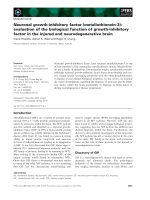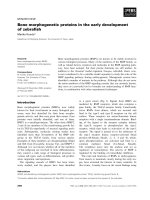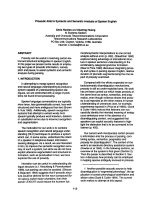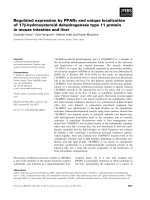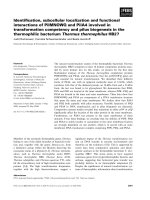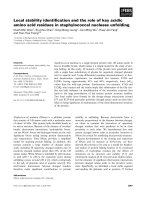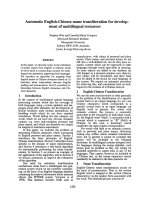Báo cáo khoa học: "Height growth, shoot elongation and branch development of young Quercus petraea grown under different levels of resource availability" pptx
Bạn đang xem bản rút gọn của tài liệu. Xem và tải ngay bản đầy đủ của tài liệu tại đây (971.09 KB, 17 trang )
Original
article
Height
growth,
shoot
elongation
and
branch
development
of
young
Quercus
petraea
grown
under
different
levels
of
resource
availability
C
Collet
F
Colin
F
Bernier
Équipe
croissance
et
production,
Inra,
centre de
Nancy,
54280
Champenoux,
France
(Received
18
April
1995;
accepted
9
March
1996)
Summary -
Two-year-old
sessile
oaks
were
grown
under
various
levels
of
resource
availability
in
a
semi-con-
trolled
conditions
experiment.
After
2
years,
the
growth
and
the
branching
of
the
seedlings
were
assessed.
A
large
number
of seedlings
showed
an
important
development
of lateral
branches
and
sprout
shoots
growing
from
the
root
collar.
Mortality
of the
apical
bud,
changes
in
the
allocation
of
shoot
elongation
between
several
shoots
and
changes
in
dominance
occurred
frequently.
Higher
resource
availability
increased
annual
shoot
elongation
by
increasing
the
number of growth
flushes
produced
in
the
growing
season
as
well
as
the
number
and
the
length
of
the
internodes
produced
in
each
flush.
Resource
availability
also
had
a
negative
effect
on
the
form
of
the
seedling, those
grown
under
high
resource
availability
showing
more
changes
in
dominance.
apical
control
/ recurrent
flushing
/ internode
/
bud
/
sprout
shoot
Résumé -
Effet
de
la
disponibilité
en
ressources
sur
la
croissance
en
hauteur,
l’élongation
des
rameaux
et
le
développement
des
branches
de jeunes
Quercus
petraea.
Des
chênes
sessiles
âgés
de
2
ans
ont
été
installés
dans
des
conditions
d’alimentation
hydrique
et
minérale
contrastées,
dans
une
expérimentation
en
milieu
semi-
controlé.
La
crois-sance
et la
branchaison
des
plants
après
deux
ans
ont
été
évaluées.
Un
grand
nombre
d’arbres
ont
présenté
un
développement
important
des
branches
latérales
et
des
rejets
se
développant
depuis
le
collet
du
plant.
L’allon-gement
des
rameaux
était
fréquemment
réparti
entre
plusieurs
tiges,
et
les
plants
ont
souvent
montré
des
changements
de
dominance
entre
les
différentes
tiges.
Le
taux
de
mortalité
des
bourgeons
apicaux
était
de
20
%
par
an.
L’amélioration
de
la
disponibilité
des
ressources
a
induit
un
plus
fort
allongement
annuel
des
rameaux,
en
augmentant le
nombre
de
vagues
de
croissance
effectuées
dans
l’année,
ainsi
que
le
nombre
et
la
longueur
des
entre-nœuds
produits
lors
de
chaque
vague
de
croissance.
En
revanche,
la
disponibilité
des
ressources
a
eu
un
effet
négatif
sur
la
forme
des
plants,
et
les
plants
placés
dans
les
meilleures
conditions
ont
montré
des
changements
de
dominance
plus
fréquents.
contrôle
apical
/
croissance
polycyclique
/
entre-nœud
/
bourgeon
/
pousse
rejet
*Correspondence
and
reprints
Tel:
(33) 03
83
39 40 43;
fax:
(33) 03
83
39 40 34; e-mail:
INTRODUCTION
Oak
(Quercus
petraea
(Matt)
Liebl
together
with
Quercus
robur
L)
is
one
of
the
most
im-
portant
commercial
timber
species
in
Europe.
In
France,
sessile
and
pedunculate
oak
cover
41
%
of the
total
commercial
forest
area
(Ningre
and
Doussot,
1993).
Traditionally,
oak
stands
were
renewed
using
natural
regeneration,
but
the
frequency
of
artificial
regeneration
by
plan-
ting is increasing
(Fernandez,
1990).
The
objec-
tive
of
artificial
regeneration
is
to
produce
fast
growing
seedlings
which
exhibit
few
branching
defects,
but
a
prerequisite
to
developing
silvi-
cultural
practices
geared
toward
this
objective
is
to
understand
the
effects
of
environmental
conditions
on
the
growth
and
branching
of
young
oaks.
Oak
grows
rhythmically:
during
the
growing
season,
shoot
elongation
occurs
by
rapid
flushes
lasting
about
2
weeks,
which
alternate
with
longer
resting
periods
(Borchert,
1975;
Reich
et
al,
1980;
Cobb
et
al,
1985;
Cham-
pagnat
et
al,
1986).
In
controlled
conditions,
young
Q
petraea
can
produce
up
to
16
succes-
sive
growth
flushes
(Lavarenne-Allary,
1965).
In
natural
conditions,
they
may
produce
up
to
four
or
five
flushes
in
a
growing
season
if
con-
ditions
are
favorable.
However,
limiting
gro-
wing
conditions
often
confine
production
to
only
one
or two
flushes, thus
restricting
the
full
growth
potential
(Lavarenne-Allary,
1965;
Longman
and
Coutts,
1974).
The
number
of
growth
flushes
produced
by
the
seedlings
in-
creases
with
resource
availability
(light,
water,
nutrients)
for
Q
rubra
L
(Phares,
1971;
Caba-
nettes
et
al,
1995),
Q
petraea
(Harmer,
1989b)
and
Q prinus
L
(Tworkoski
et
al,
1990).
Resource
availability
may
influence
annual
shoot
elongation,
through
an
effect
on
the
num-
ber
of
flushes
produced
annually,
but
also
through
an
effect
on
shoot
elongation
during
each
growth
flush:
Harmer
(1989a,
b)
noted
a
positive
effect
of fertilization
on
shoot
length
of
Q petraea.
Shoots
can
be
divided
into
nodes
which
are
the
points
of the
stem
where
a
lateral
appendage
(foliar
or
scale
leaf)
is
attached,
and
internodes
which
are
the
portions
of
stem
be-
tween
two
nodes
(Critchfield,
1985).
Shoots
elongate
as
the
result
of
the
production
of
new
nodes
by
the
apical
meristem
and
the
elongation
of
the
internodes
in
the
subapical
part
of
the
shoot.
Apical
and
subapical
activities
constitute
two
dis-
tinct
processes
and
are
both
under
the
control
of
environmental
and
internal
factors
(Kozlowski,
1971).
For
Q prinus
seedlings,
Tworkoski
et
al
( 1990)
observed
that resource
availability
did
not
influence the
number
or the
length
of internodes,
whereas
on
Q
petraea
seedlings,
Harmer (1989a)
showed
that
a
better
resource
availability
increa-
sed
the
number
of internodes
but
had
no
effect
on
internode length.
On
other species,
both internode
number
and
length
have
been
shown
to
increase
in
response
to
higher
resource
availability
(Ko-
zlowski,
1971).
Oak
is
described
as
having
strong
apical
do-
minance
and
weak
apical
control.
The
develo-
pment
of
the
lateral
buds
produced
during
the
current
flush
is
inhibited
by
the
apex
of
the
shoot,
but
these
buds
may
develop
into
shoots
during
the
next
growth
flush
(Brown
et
al,
1967).
The
lack
of
strong
apical
control
in
young
oaks
induces
branching
defects
which
may
persist
and
reduce
the
future
value
of
the
stem.
Many
authors
have
reported
the
frequent
occurrence
of
seedlings
developing
a
multi-
stemmed
morphology,
which
results
from
the
death
of
the
top
or
of the
entire
stem,
followed
by
respouting
of
shoots
from
dormant
buds
at
the
root
collar
(Bey,
1964
on
Q
alba
L,
Q
velu-
tina
Lam
and
Q
coccinea
Muenchh;
Hibbs
and
Yoder,
1993
on
Q
garryana
Dougl;
Collin
et
al,
1986; Crow,
1988,
1992;
Cabanettes et al,
1995
on
Q
rubra).
According
to
Hibbs
and
Yoder
(1993),
stem
dieback
and
subsequent
sprouting
of
new
stems
may
be
related
to
low
moisture
availability.
On
the other
hand,
high
resource
availability
may
increase
branching
defects
by
inducing
multiple
flushing.
Indeed,
multiple
flushing
has
been
shown
to
be
associated
with
increased
lateral
branch
production
(Harmer,
1989a,
b
on
Q
petraea).
Furthermore, an
impor-
tant
part
of
the
growth
may
be
allocated
to
the
lateral
branches
and
the
sprouting
shoots,
and
multiple flushing
may
be
associated
with
a
strong
development
of the
lateral
shoots
(Caba-
nettes
et
al,
1995
on
Q
rubra).
The
mechanisms
of
inhibition
of
lateral
shoots
in
trees
have
been
widely
studied,
and
most
investigators
stress
the
importance
of
the
control
on
the
axillary
buds
by
the
apical
part
of
the
shoot
(Kramer
and
Kozlowski,
1979).
Observations
of the
effects
of the
natural
death
of
the
apical
bud
during
the
winter,
and
of
ex-
perimental
decapitation
of
the
shoot
apex
on
Q petraea,
have
clearly
shown
that
loss
of
the
apical
bud
increases
lateral
branch
production
(Harmer,
1992b,
1995).
In
addition
to
the
sti-
mulation
of
lateral
branch
development,
the
death
of
the
apical
bud
may
also
cause
a
croo-
ked
stem
form
(Harmer,
1992b). In
natural
con-
ditions,
the
death
of
the
apical
bud
during
the
winter
is
not
uncommon
(Drénou,
1994
on
Q
robur).
Moreover,
it is
well
known
that
high
resource
availability,
which
allows
the
growth
of
abnormal
late-season
shoots,
may
induce
the
formation
of
a
terminal
bud
which
is
more
sus-
ceptible
to
winter injury
because
it
has
not
ade-
quately
hardened
(Kozlowski,
1971
). Thus,
one
might
expect that
resource
availability
may
in-
crease
the
occurrence
of
death
of the
apical
bud
and,
therefore,
may
increase
the
occurrence
of
branching
defects.
These
studies
clearly
show
that
resource
availability
strongly
influences
both
the
growth
and
the
branching
of
oak
seedlings,
and
that
there
may
be
a
trade-off
between
the
two
para-
meters.
These
results,
however,
are
based
on
a
variety
of
oak
species
and
more
information
for
individual
species
is
needed.
The
objective
of
our study
was to
describe
the
effects
of resource
availability
on
the
growth
and
branching
of
Q petraea
seedlings,
and
to
examine
if
there
is
a
trade-off between
growth
and
branching
when
grown
under
various
levels
of
resource
availa-
bility.
The
material
we
used
came
from
a
larger
experiment
investigating
the
combined
effects
of
herbaceous
competition
and
irrigation
on
oak
seedlings
(Collet
et
al,
1996).
MATERIALS
AND
METHODS
One-year-old
sessile
oak
seedlings
(Q
petraea)
were
collected
in
March
1991
from
a
selected
seed
stand
within
a
naturally
regenerating
fo-
rest,
in
the
Moselle
region
(northeastern
France), and
stored. In
June
1991, 200
seedlings
were
transplanted
into
40
large
boxes
(2
m
width
x
2
m
width
x
0.6
m
depth)
built
under
a
transparent
plastic
roof
and
containing
a
fertile
sandy
loam
soil.
Twenty
randomly
chosen
boxes
were
sown
with
Deschampsia
cespitosa
(L)
Beauv
seeds,
and
the
remaining
boxes
were
kept
without
grass.
The
grass
and
the
bare
soil
were
maintained
by
regular
manual
weeding
for
3
years.
In
the
first
year
(1991),
all
the
boxes
were
well-watered
so
the
plants
could
establish.
In
1992
and
1993,
half
of
the
boxes
sown
with
Deschampsia
were
subjected
to
summer
drought,
while
the
other
half
were
regularly
ir-
rigated
throughout
the
growing
season.
Meas-
urements
of
foliar
nutrient
(N,
P,
K,
Ca,
Mg)
concentration
made
at
the
end
of
1992
indicated
that
nutrient
supply
was
slightly
lower
in
the
two
grass
treatments.
Measurements
of soil
wa-
ter potential
during
summer
1992
and
1993
sho-
wed
that
in
both
years
soil
water
potential
stayed
close
to
the
maximum
in
the
bare
soil
and
grass
irrigated
treatments,
and
decreased
to
-
2 MPa
in
the
grass
nonirrigated
treatment,
in-
dicating
a
strong
water
deficit.
The
three
treat-
ments
corresponded
to
three
levels
of
growing
conditions
for
the
oak
seedlings:
high
resource
availability
(H,
bare
soil),
medium
resource
availability
(M,
grass
and
irrigation)
and
low
resource
availability
(L,
grass
and
no
irriga-
tion).
Eighteen,
30
and 30
seedlings
were
sampled
in
treatments
H,
M
and
L,
respectively.
At
the
end
of
each
year,
total
height
of
each
seedling
was
measured.
In
November
1993,
the
leading
axis,
or
axes,
of
the
seedlings
were
de-
termined,
and
selected
for
growth
measure-
ments.
We
defined
a
leading
axis
as
a
shoot
de-
veloped
before
1992,
which
grew
vertically
and
which
could
build
the
future
stem.
Only
the
do-
minant
axis
was
selected
on
single-stemmed
seedlings,
whereas
two
or
three
codominant
axes
were
selected
on
multi-stemmed
see-
dlings.
On
these
axes,
all
the
growth
units
pro-
duced
during
1992 and
1993
were
delimited.
A
growth
unit
(GU)
is
the
portion
of
a
shoot
pro-
duced
during
a
single
growth
flush
(Barthélémy
and
Caraglio,
1991).
The
GUs
are
delimited
by
scars
left
by
the
scales
which
protected
the
api-
cal
bud
during
the
resting
period
(fig
1).
Each
GU
consists
of
a
series
of internodes
of
variable
length.
Internodes
located
at
the
base
of
the
GU
are
very
short,
those
in
the
middle
are
longer
and
those
at
the
top
are
short
(Champagnat
et
al,
1986).
The
total
number
of axes
and
GUs
we
sampled
in
each
treatment
for
the
growth
des-
cription
are
given
in
table
I.
The
number
of
trees
or
axes
sampled
may
be
higher
than
the
number
of
GUs
for
some
flushes
because
the
trees
did
not
necessarily
produce
GUs
in
each
flush.
On
the
other
hand,
the
number
of
trees
or
axes
sampled
may
be
lower
than
the
number
of
GUs,
because
some
axes
forked
and
the
two
shoots
were
then
sampled.
When
possible
we
determi-
ned
for
each
GU, the
year
and
the
flush
number
during
which
the
GU
grew
by:
i)
counting
the
scars
delimiting
the
GUs,
ii)
looking
at
the
as-
pects
of the
bark
and
iii)
for
the
GUs
produced
in
1993, looking
at
leaf
characteristics
(size,
as-
pects).
The
length
of
each
GU
produced
in
1993
was
measured,
and
on
each
GU
all
the
interno-
des
of
significant
(ie,
visible)
length
were
coun-
ted.
The
fate
(alive,
dead
or
developed
into
shoot)
of the
terminal
and
axillary
buds
on
each
GU
was
assessed.
The
following
variables
were
assessed
and
analyzed
for
each
axis
or
for
each
seedling:
i)
annual
height
increment,
ii)
number
of
growth
flushes
produced
each
year,
iii)
length
of
the
GUs
elongated
during
each
flush,
iv)
number
and
v) length
of the internodes
produced
during
each
flush,
vi)
appearance
of sprout shoots,
vii)
development
of
axillary
buds
into
lateral
shoots,
viii) location
on
the
seedling
of the long-
est
GU
of
each
flush
and
ix)
fate
of
the
apical
bud.
RESULTS
Seedling
height
Seedling
height
growth
was
related
to
the
level
of
resource
availability
(table
II).
By
the
end
of
the
first
growing
season,
seedlings
were
signi-
ficantly
taller in
treatment
H
than
in
treatments
L and
M.
Significant
differences
between
treat-
ments
L and
M
appeared
during
the
third
gro-
wing
season.
By
the
end
of
1993, seedlings
gro-
wing
in
treatment
H
averaged
three
times
the
height
of
seedlings
growing
in
treatment
L.
Number
of
growth
flushes, length
of
the
growth
units
and
number
of internodes
Most
of
the
seedlings
in
treatments
L and
M
produced
one
or
two
growth
flushes
in
1992,
and
two
flushes
the
next
year
(table
III).
In
treatment
H,
most
of
the
seedlings
produced
four
flushes
in
1992
and
three
flushes
in
1993.
The
lower
number
of
growth
flushes
produced
in
1993
by
the
seedlings
from
treatment
H
was
clearly
related
to
cold
temperatures
which
oc-
curred
at the
end
of
September
1993
and
which
completely
stopped
shoot
elongation.
The
GUs
were
always longest in
treatment
H
and
shortest
in
treatment
L,
but
differences
were
significant
only
for
the
second
flush
of
1992,
and
for
the
first
and
second
flush
of
1993.
In
both
years,
average
values
ofGU
length
increased
with
the
flush
number,
from
36.8
to
344.0
mm
between
the
first
and
the
fourth
flush
in
1992,
and
from
113.1
to
404.6
mm
between
the
first
and
the
third
flush
in
1993.
The
GUs
from
the
fourth
flush
of
1993
were
shorter
because
their
elon-
gation
was
stopped
by
cold
temperatures.
The
number
of
internodes
per
GU,
calculated
for
all
the
treatments
pooled,
is
shown
in
fig-
ure 2 for
each
growth
flush
in
1992
and
in
1993.
The
distributions
were
all
unimodal,
with
va-
lues
ranging
between
extremes
of
2 and
35.
In
both
years,
the
modal
class
value
increased
when
the
flush
number
increased.
The
average
number
of
internodes
per
GU
was
generally
higher
in
treatment
H
than
in
treatments
L and
M
during
each
growth
flush,
but
differences
were
significant
only
for
the
first
and
second
flushes
of
1993
(table
IV).
For
each
GU,
average
intemode
length
was
cal-
culated
as
GU
length
divided
by
the
number
of
intemodes
(table
IV).
In
1992,
average
internode
length
did
not
differ
significantly
between
the
three
treatments,
and
increased
from
4.4
mm
in
the
first
growth
flush
to
12.8
mm
in
the
third
flush.
In
1993,
significant
differences
were
found
among
the
treat-
ments.
The
intemodes
were
on
average
longer
in
treatment
H
than
in
treatments
L and
M.
Differences
in
average
intemode
length
among
treatments
and
flushes
were
related
to
a
greater
elongation
of
the
intemodes,
and
not
to
variations
in
the
proportion
of
short
internodes
(located
at
the
base
and
at
the
top
of
the
GU)
since
this
number
was
similar
among
treat-
ment
and
flushes
(data
not
shown).
Longer
GUs
were
associated
with both
a
higher
number
of
internodes
and
longer
inter-
nodes.
The
relationship
between
the
number
of
internodes
and
GU
length
measured
in
1993
is
shown
in
figure
3.
A
graphic
analysis
showed
that the
relationship
between
GU
length
and
the
number
of
internodes
was
similar
in
the
three
treatments;
thus,
data
from
the
different
treat-
ments
were
pooled.
No
differences
appeared
among
the
second,
third
and
fourth
flushes;
only
the
first
flush
differed.
Therefore,
data
from
the
second,
third
and
fourth
flushes
were
pooled.
These
data
and
the
data
from
the
first
flush
were
then
fitted
separately
with
a
logistic
nonlinear
model:
where
L
is
the
length
of
the
GU
expressed
in
mm,
n
is
the
number
of internodes,
and
K,
a
and
n0
are
the
parameters
of the
model (table
V).
Differences
between
the
regressions
performed
on
the
two
sets
of
data
were
significant
[F
(3,
393)
=
98.44**].
The
differences
we
observed
in
average
inter-
node
length
between
the
treatments
and
be-
tween
the
growth
flushes
were,
except
for
the
first
flush,
only
associated
with
differences
in
GU
length.
In
contrast,
differences
in
average
internode
length
in
the
first
flush
were
also
as-
sociated
with
a
different
relationship
between
the
number
of
internodes
and
GU
length.
Death
of
the
apical
bud
The
frequency
of
the
death
of
the
resting
apical
buds
was
higher in
winter than
during
the growing
season
(table
VI).
Eighteen
percent
of
the
apical
buds
produced
during
the
1992
growing
season
died
during
the
next
winter,
and
7%
of the
apical
buds
produced
in
the
1993
growing
season
died
during
the
resting
periods
between
two
growth
flushes.
There
was
no
statistically
significant
difference
among
the
three
treatments.
Development
of
axillary
buds
into
shoots
At
the
end
of
each
year,
lateral
branches
on
the
current
year
shoot
were
not
uniformly
distribu-
ted.
More
branches
appeared
on
the
GUs
from
the
first
flush
than
on
the
GUs
from
the
second
or
third
flush,
and
branches
were
formed
on
the
GUs
of
the
last
flush.
In
contrast,
after
2
years,
branch
formation
was
more
important
on
the
GUs
from
the
late
flushes.
The
increased
branch
formation
on
the
late
flushes
was
a
consequence
of
both
a
higher
number
of
axillary
buds
produ-
ced
on
the
GU,
and
a
higher
proportion
of
buds
growing
into
shoots.
The
number
of
1992 buds
which
developed
into
shoots
the
same
year
was
much
higher
in
treatment
H
than
in
treatments
L and
M
(table
VII).
In
con-
trast,
the
number
of
1992 buds
forming
shoots
the
next
year
was
lower
in
treatment
H.
Over
the
2
years,
differences
between
the
treatments
in
the
number
of
buds
which formed
shoots
varied
ac-
cording
to
the
flush
number:
more
branches
grew
from
the
buds
produced
during
the
first
flush
of
1992
in
treatment
H
than
in
treatments
L and
M,
whereas
no
differences
occurred
between
the
treatments
for the
buds
formed
during
the
second
and
third
flush
of
1992.
The
1993
buds
behaved
similarly
to
the
1992
buds
during
their
first
year.
Development
of
sprouts
We
defined
a
sprout
as a
shoot
produced
from
a
bud
located
at
the
root
collar
of
the
seedling.
Thirty
percent
of the
seedlings
produced
at least
one
sprout
during
1992
and
1993
(table
VIII),
and
about
one-fifth
of
those
sprouts
developed
into
leading
axes
(data
not
shown).
There
was
no
statistically
significant
difference
for
sprout
formation
among
the
treatments.
Changes
in
the
leading
axes
Changes
in
the
leading
axes
between
the
begin-
ning
and
the
end
of the
growing
season
occurred
frequently.
Thirty-eight
percent
of the
seedlings
in
treatments
L and
M, and
84%
of the
seedlings
in
treatment
H,
showed
at
least
one
change
in
1992
or
1993
(table
IX).
The
differences
be-
tween
the
treatments
were
significant
(χ2
=
12.86,
df
= 2,
P
<
0.01). In
the
three
treat-
ments,
changes
occurred
more
frequently
in
1992
than
in
1993,
and
some
seedlings
exhibi-
ted
a
change
both
years.
On
70%
of
the
see-
dlings
which
experienced
a
change,
the
domi-
nant
axis
became
codominant
with
other
axes,
and
on
30%
of the
seedlings, the
dominant
axis
became
dominated
by
other
axes.
Fifty
percent
of
the
changes
occurring
in
1993
occurred
on
seedlings
for
which
the
apical
bud
of the
domi-
nant
axis
died
during
the
previous
winter
(data
not
shown).
Changes
in
the
leading
axes
are
related
to
the
allocation
pattern
of
shoot
elongation
between
the
different
axes.
In
60%
of the
seedlings, the
longest
GUs
produced
during
the
different
growth
flushes
were
found
on
different
shoots
(table
X). In
the
remaining
40%,
one
shoot
pro-
duced
the
longest
GUs
for
all
growth
flushes.
The
proportion
of
seedlings
which
showed
changes
in
the
location
of
the
longest
GU
did
not
seem
to
be
related
to
the
number
of
growth
flushes
produced
nor to
the
treatment.
Within
a
growing
season
the
longest
GUs
could
change
between
two
or
three
axes,
as
illustrated
by
the
example
in
figure
4.
These
changes
may
occur
between
codominant
axes
which
were
present
at the
beginning
of the
growing
season
(44%
of
the
seedlings)
between
the
dominant
axis
and
a
sprout
(23%
of
the
seedlings),
or
between
the
leader
shoot
of the
dominant
axis
and
its
lateral
shoots
(33%
of the
seedlings)
(table
XI).
DISCUSSION
The
Q petraea
seedlings
showed
a
growth
(height
increment
and
flushing
recurrence)
si-
milar
to
young
oaks
under
natural
conditions
planted
on
a
good
quality
site
with
or
without
grass
competition
(Collet
and
Frochot,
1996).
Seedlings
in
treatment
H
and
those
in
treatments
L and
M
grew
similarly
to
seedlings
planted
in
good
or
medium
conditions,
respectively.
No
treatment
reflected
the
poor
conditions
which
of-
ten
prevail
in
oak
plantations,
and
where
the
growth
and
the
survival
rates
of
the
seedlings
are
low.
In
such
conditions,
the
response
of
the
see-
dlings,
in
terms
of
growth
and
branching,
may
be
more
pronounced
than
what
we
described.
The
environmental
conditions
in
our
experiment
were
close
to
conditions
prevailing
in
oak
plantations
where
the
vegetation
is
completely
suppressed
(treatment
H)
or
were
the
hardwood
vegetation
is
controlled
(treatments
L and
M).
These
conditions
are
very
different
from
those
found
in
natural
regeneration,
or
in
plantations
where
the
hard-
wood
vegetation
is
still
present
(Temen,
1994).
In
such
conditions,
the
seedlings
probably
grow
and
develop
very
differently
from
the
seedlings
in
our
experiment.
In
France,
however,
oak
regeneration
by
planting
is
increasing
(Fernandez,
1990),
ve-
getation
control
is
strongly
recommended
in
order
to
enhance
initial
seedling
growth
(Frochot
et
al,
1986)
and
the
conditions
created
in
such
regene-
ration
are
close
to
those
in
our
experiment.
Shoot
elongation
Resource
availability
influenced
annual
shoot
elongation
by
modifying
both
apical
and
suba-
pical
activity.
The
total
number
of
growth
flushes
produced
in
the
growing
season,
the
number
of
internodes
produced
in
each
flush
and
the
average
internode
length
increased
with
higher
resource
availability.
However,
the
number
of
flushes
differed
among
the
three
treatments
in
both
years
whereas
the
number
and
the
length
of
the
internodes,
responded
to
treatments
only
in
1993
and
rarely
differentia-
ted
between
treatments
L and
M.
The
higher
responsiveness
of
the
number
of
flushes
to
variations
in
resource
availability,
compared
to
the
number
and
the
length
of
the
internodes
has
been
also
observed
by
Harmer
(1989a)
on
Q
pe-
traea
and
Tworkoski
et
al
(1990)
on
Q prinus.
This
is
probably
related
to
the
fact
that
the
three
variables
integrate
different
periods
of
time:
the
number
of
flushes
reflects
the
growth
over
the
entire
growing
season,
whereas
the
number
and
the
length
of
the
internodes
in
each
flush
reflect
the
growth
over
shorter
periods
of
time.
A
consequence
is
that
variations
in
annual
shoot
elongation
were
more
related
to
varia-
tions
in
the
number
of flushes
than
to
variations
in
the
number
or
the
length
of
the
internodes
in
each
flush.
Furthermore,
since
the
GUs
of
the
late
flushes
appeared
to
be
longer
than
the
GUs
of
the
early
flushes,
their
production
constitu-
tes
an
important
part
of
annual
growth,
and
an-
nual
shoot
elongation
is
strongly
related
to
the
total
number
of
flushes
produced
in
the
gro-
wing
season
(fig
5).
Longer
late-season
GUs,
compared
to
early-season
GUs,
has
also
been
reported
by
Harmer
(1992a)
on
Q
petraea,
and
by
Tworkoski
et
al
(1990)
on
Q prinus.
In
the
experiment,
Tworkoski
et
al (1990)
noted
no
difference
in
the
length
of GUs
from
succes-
sive
flush
on
Q
coccinea
seedlings,
and
Cobb
et
al
(1979)
even
noted
shorter
late-season
GUs
on
seedlings
of
the
same
species.
In
species
which
produce
late-season
GUs
shorter
than
the
early-season
GUs,
annual
shoot
elongation
is
determined
more
by
the
length
of
the
GUs
in
each
flush
(thus
by
the
number
and
the
length
of
the
internodes)
than
by
the
number of flushes
(Kozlowski,
1971).
In
contrast,
in
Q petrueu,
which
tends
to
produce
longer
late-season
GUs,
annual
shoot
elongation
is
mainly
determined
by
the
number
of
flushes.
Apical
control
The
seedlings
from
the
three
treatments
exhibi-
ted
weak
apical
control,
which
was
revealed
by
the
development
of
dormant
buds
into
lateral
branches
and
sprout shoots,
and
by
the
changes
in
the
allocation
of
the
longest
GUs.
All
the
axillary
buds
located
on
the
currently
elongating
GUs
were
inhibited
by
the
apical
meristem
and
did
not
develop
into
shoots,
whe-
reas
a
high
proportion
of the
buds located
on
the
previously
formed
GUs
grew
into
shoots.
These
observations
agree
with
those
of
Brown
et
al
(1967)
who
described
oak
as
having
strong
api-
cal
dominance
and
weak
apical control.
The
ter-
minology
of
apical
dominance
versus
apical
control
has
proved
to
be
useful
to
describe
ge-
neral
patterns
of
tree
growth
(Brown
et
al,
1967).
In
species
having
a periodic
growth
such
as
oak,
it
is
possible
to
refine
the
notion
of apical
control,
and
to
distinguish
an
inter-annual
api-
cal
control
which
designates
the
pattern
of
bud
inhibition
on
previous
year
GUs,
and
an
intra-
annual
interflush
apical
control
which
designa-
tes
the
pattern
of
inhibition
of
the
buds
located
on
the
GUs
formed
during
the
previous
flushes
of
the
current
year.
On
the
seedlings
from
the
three
treatments,
both
inter-
and
intra-annual
apical
control
were
weak.
Lateral
branch
production
appeared
to
be
strongly
dependent
on
the
total
number
of
flushes
produced
by
the
seedling.
A
bud
formed
during
a
given
growth
flush
may
turn
into
a
shoot
during
each
subsequent
flush
and
there-
fore
the
opportunity
for
each
bud
to
form
a
shoot increases
with
the
number
of flushes
pro-
duced.
Moreover,
for
a
bud
formed
during
a
given
flush,
each
subsequent
flush
may
reduce
the
inhibition
exerted
by
the
apical
meristem
and,
therefore,
may
increase
the
capacity
of
the
bud
to
develop.
We
found
a
significant
positive
effect
of
re-
source
availability
on
branch
formation
during
the
first
year.
In
a
1 year
experiment,
Harmer
(1989b)
also
noted
a positive
effect
of
mineral
nutrition
on
lateral
branch
production.
How-
ever,
this
effect
disappeared
in
the
second
year
and
no
clear
among-treatment
differences
oc-
curred
in
the
number
of
lateral
branches
pre-
sent
on
a
GU
after
2
years.
Nevertheless,
in
treatment
H
most
of
the
lateral
branches
loca-
ted
on
the
GUs
from
the
first
and
second
flushes
were
formed
in
the
same
year
as
the
GUs
on
which
they
grew.
In
contrast,
in
treat-
ments
L and
M
most
of
the
lateral
branches
grew
during
the
next
year.
As
a
consequence,
at
the
end
of
1993,
the
lateral
branches
which
de-
veloped
on
the
1992
shoot
were
older
and
were
probably
more
developed
in
treatment
H
than
in
treatments
L and
M.
Sprout
shoots
developing
from
dormant
buds
located
at
the
collar
of
the
seedling
appeared
on
40%
of
the
seedlings.
This
frequently
occurs
following
shoot
dieback
on
young
oaks
gro-
wing
in
natural
conditions,
as
previously
repor-
ted
by
Liming
and
Johnston
(1944,
on
various
oak
species),
Merz
and
Boyce
(1956),
Sander
(1971),
Johnson
(1979,
on
Q velutina
and
Q
alba),
Tryon
and
Powell
(1984,
on
various
oak
species),
Crow
(1988,
1992,
on
Q
rubra),
Hibbs
and
Yoder
(1993,
on
Q
garryana)
and
Cabanettes
et
al
(1995,
on
Q
rubra).
The
deve-
lopment
of
sprout
shoots
which
replace
the
lea-
ding
shoot
has
been
described
as
resulting
from
poor
growing
conditions.
Tryon
and
Powell
(1984)
suggested
that
it
could
result
from
stem
suppression
due
to
light
limitation,
whereas
Crow
(1988)
argued
that
this
could
be
a
res-
ponse
to
soil
water
deficit
because
it
reduces
the
shoot-to-root
ratio.
However,
Crow
(1992)
sho-
wed
that
seedlings
grown
under
light-limiting
conditions
developed
less
sprout
shoots,
and
observations
made
by
Hibbs
and
Yoder
(1993)
did
not
support
the
hypothesis
that
development
of
sprout
shoots
were
the
consequence
of
low
water
availability.
In
our
experiment,
the
light
conditions
were
not
limiting,
and
we
observed
no
statistically
significant
effect
of
resource
availability
on
the
occurrence
of
sprout
shoots.
Therefore,
the
appearance
of
sprout
shoots
was
not
clearly
related
to
limitation
of resource
avai-
lability.
The
apical
control
of
a
tree
is
characterized
by
the
differences
in
bud
development
and
in
shoot
elongation
among
variously
located
shoots
(Zimmermann
and
Brown,
1971;
Kramer
and
Kozlowski,
1979).
In
addition
to
lateral
branch
and
sprout
shoot
production,
another
expres-
sion
of
the
weak
apical
control
was
the
frequent
within-season
changes
of
axes
having
maxi-
mum
elongation.
The
longest
GU
of
each
flush
was
not
produced
by
the
same
shoot,
but
by
several
shoots
for
more
than
half
of
the
see-
dlings.
Cabanettes
et
al
(1995)
also
reported
changes
in
maximum
elongation
on
Q
rubra
seedlings,
although
they
did
not
quantify
the
frequency
of
occurrence.
A
consequence
of
the
lack
of
strong
apical
control
was
the
frequent
changes
in
the
domi-
nant
axis
occurring
within
a
growing
season.
This
was
recorded
on
50%
of
the
seedlings.
Changes in
dominance
resulted
from
the
appea-
rance
of
sprout
shoots
and
lateral
branches,
and
from
the
changes in
the
allocation
of the longest
GUs
between
different shoots.
Although
no
sta-
tistically
significant
among-treatment
differen-
ces
arose
for
any
of these
three
mechanisms, the
occurrence
of changes in
dominance
significan-
tly
differed
among
the
three
treatments.
Changes
in
the
allocation
of
the
longest
GUs
occurred
most frequently
in
treatment
H, sprout
shoots
appeared
least
frequently
in
treatment
H
(although
differences
were
never
statistically
significant)
and
branch
production
did
not
clearly
vary
with
treatment.
Changes
in
domi-
nance
occurred
much
more
frequently
in
treat-
ment
H
than
in
the
two
other
treatments.
To-
gether,
these
observations
suggest
that
dominance
changes
may
be
most closely
related
to
changes
in
the
allocation
of
the
longest
GUs
among
several
axes
rather
than
to
the
develo-
pment
of
new
axes.
In
fact,
the
proportion
of
changes
occurring
between
two
codominant
axes
or
between
a
dominant
and
a
sprout
or
a
lateral
branch
varied
among
the
treatments.
In
treatment
H,
where
the
longest
GUs
were
fre-
quently
located
on
several
axes, the
percentage
of
changes in
dominance
occurring
between
two
co-
dominant axes
was
higher. In
treatments
M
and
L,
however,
where
sprout
shoot
development
was
frequent, the
percentage
of changes in
dominance
occurring
between
a
dominant
and
a
sprout
or la-
teral
branch
was
higher.
As
a
result,
changes
in
dominance
were
the
consequence
of
both
the
ap-
pearance
of sprout shoots
and
lateral
branches
and
the
allocation
of maximum
elongation
to
different
shoots.
The
relative
importance
of
these
processes
varied
with
the
growing
conditions.
While
these
results
show
that
dominance
changes
can
occur
very
frequently
in
young
oaks,
it is
unclear
how
long
these
changes
might
continue,
and
at
what
point
a
single
axis
will
start
to
dominate
and
outgrow
the
other
axes
to
build
the
future
stem
of
the
tree.
Half
of
the
changes
in
dominance
were
asso-
ciated
with
the
death
of
the
apical
bud
of
the
dominant
axis.
The
high
frequency
of
apical
bud
death
(20%
of
all
apical
buds,
each
year)
contradicts
the
usual
assertion
that
shoot
elon-
gation
in
oak
is
monopodial,
based
on
obser-
vations
made
in
controlled
environments
(Kra-
mer
and
Kozlowski,
1979;
Champagnat,
1989).
Our
observations
agree
with
those
made
by
Drénou
(1994,
on
Q
robur)
who
reported
that
young
sessile
oaks
often
showed
monopo-
dial
growth
during
the
growing
season
and
sympodial
growth
at
the
beginning
of each
gro-
wing
season.
Apical
bud
growth
in
oak
is
po-
tentially
indeterminate,
and
when
growing
un-
der
good
conditions,
seedlings
show
monopodial
shoot
elongation.
However,
the
apical
bud
is
sensitive
to
environmental
factors
such
as
cold
temperatures,
mildew
and
aphid
attacks.
Under
natural
conditions,
death
of
the
apical
bud
occurs
frequently,
leading
to
sym-
podial
growth.
The
proportion
of
shoots
sho-
wing
monopodial
or
sympodial
growth
de-
pends
on
the
environmental
conditions.
We
did
not
observe
any
effect
of
resource
availability
on
the
death of
the
apical
buds.
However,
it
must
be
noted
that
1991
and
1992
had
mild
winters
with
no
early
or
late
frost.
Ear-
ly
frost
occurred
at
the
end
of
summer
1993
and
stopped
the
elongation
of the
shoots
which
were
still
growing.
Important
among-treatment
dif-
ferences
in
the
frequency
of
apical
bud
death
may
have
arisen
this
year,
since
the
seedlings
in
treatment
H
were
still
growing
when
the
frost
occurred,
whereas
the
seedlings
in
treatments
L
and
M
had
already
stopped
growth
and
develo-
ped
frost-hardened
buds.
Height
growth
Seedling
height
increment
is
a
function
of
i)
the
vigor
of
the
plant,
which
determines
the
poten-
tial
elongation
of the
dominant
shoot,
and
ii)
the
apical
control
of
the
plant,
which
determines
how
potential
shoot
elongation
is
allocated
be-
tween
the
dominant
shoot
and
the
other
shoots.
In
oaks,
because
they
show
weak
apical
control,
potential
shoot
elongation
may
not
be
allocated
exclusively
to
the
dominant
axis,
and
important
losses
in
height
growth
may
then
occur.
There-
fore,
to
predict
the
height
increment
of
a
see-
dling,
it
is
necessary
to
evaluate
its
apical
con-
trol in
addition
to
its
vigor. In
our
study,
seedling
vigor
could
be
estimated
from
the
number
of
growth
flushes
produced,
and
apical
control
from
the
frequency
of
changes
in
dominance.
Actually,
the
number
of
flushes
is
determinant
for
annual
shoot
elongation,
and
changes
in
do-
minance,
being
the
consequence
of both
lateral
shoot
formation
and
elongation,
constitute
a
synthetic
expression
of
apical
control.
Resource
availability
can
influence
both
the
vi-
gor
of
a
seedling
and
its
apical
control.
As
expec-
ted,
we
found
that
better
resource
availability
in-
duced
higher
vigor
for
the
seedlings.
But
a
trade-off
between
the
vigor
and
the
apical
control
occurred
as
seedlings
growing
under
high
re-
source
level
also
showed
weaker
apical
control
and
exhibited
more
changes
in
dominance.
ACKNOWLEDGMENTS
We
are
indebted
to
M
Pitsch
and
L
Wehrlen
for
their
valuable
assistance
with
field
work
and
data
collection,
and
to
H
Frochot
for
extended
discussions
during
this
work.
We
are
also
gra-
teful
to
D
Barthélemy
and
F
Courdier
who
hel-
ped
us
to
describe
seedling
architecture,
to
R
Harmer,
F
Ningre,
D
Sandquist
and
two
ano-
nymous
reviewers
who
provided
useful
com-
ments
on
early
drafts
of
the
paper.
REFERENCES
Barthélemy D,
Caraglio
Y
(1991)
Modélisation
et
si-
mulation
de
l’architecture
des
arbres.
Forêt-En-
treprise
73,
28-39
Bey
CF
(1964)
Advance
oak
reproduction
grows
fast
after
clearcutting.
J
For
62,
339-340
Borchert
R
(1975)
Endogenous
shoot
growth
rhythms
and
indeterminate
shoot
growth
in
oak.
Physiol
Plant 35,
152-157
Brown
CL,
McAlpine
RG,
Kormanik
PP (1967)
Api-
cal
dominance
and
form
in
woody
plants:
a
reap-
praisal.
Am
J Bot 54,
153-162
Cabanettes
A,
Courdier
F,
Meredieu
C,
Trichet
P
( 1995)
Facteurs et expression
du polycyclisme ju-
vénile
chez
le
chêne
rouge
d’Amérique
(Quercus
rubra
L)
planté
en
conditions
naturelles.
Ann
Sci
For
52,
489-506
Champagnat
P (1989)
Rest
and
activity
in
vegetative
buds
of
trees.
Ann
Sci
For
46
(Suppl),
9s-26s
Champagnat
P,
Payan
E,
Champagnat
M,
Barnola
P,
Lavarenne
S,
Bertholon
C
(1986)
La
croissance
rythmique
de
jeunes
chênes
pédonculés
cultivés
en
conditions
controlées
et
uniformes.
In:
L’arbre.
Naturalia
monspeliensa,
colloque
international
sur
l’arbre,
1985, 303-337
Cobb
SW,
Miller
AE,
Zahner
R
(1985)
Recurrent
shoot flushes
in
scarlet oak
stump
sprouts.
For Sci
31, 725-730
Collet
C,
Frochot
H
(1996)
Effects
of
interspecific
competition
on
shoot
elongation
in
Quercus
pe-
traea
seedlings.
Can
J
For Res
26
(in
press)
Collet
C,
Guehl
JM,
Frochot
H,
Ferhi
A
( 1996)
Effect
of
two
forest
grasses
differing
in
their
growth
dyna-
mics
on
the
water
relations
and
the
growth
of
Quer-
cus
petraea
seedlings.
Can
J
Bot
74,
1562-1571
Collin
P,
Badot
P,
Millet
B
(1986)
Étude
comparée
de
la
croissance
et
du
développement
du
frêne
com-
mun,
Fraxinus
excelsior
L,
et
du
chêne
rouge -
d’Amérique,
Quercus
rubra
L,
cultivés
en
conditions
contrôlées.
In:
Le
rythme
de
croissance,
base
de
l’or-
ganisation
temporelle
de
l’arbre.
Colloque
«
Le
groupe
de
l’arbre
» 1993,
Angers,
France,
74-96
Critchfield
WB
( 1985)
Internode
or
stem
unit:
a
prob-
lem
of
terminology.
For Sci
31,
911-912
Crow
TR
(1988)
Reproductive
mode
and
mecha-
nisms
for
self-replacement
of
northern
red
oak
(Quercus
rubra).
A
review.
For Sci
34,
19-40
Crow
TR
(1992)
Population
dynamics
and
growth
patterns
for
a
cohort
of northern
red
oak
(Quercus
rubra)
seedlings.
Oecologia
91, 192-200
Drénou
C
(1994)
Approche
architecturale
de
la
sénes-
cence
des
arbres.
Le
cas
de
quelques
angiosper-
mes
tempérées
et
tropicales.
Thesis,
université
Montpellier-II,
Montpellier,
France
Fernandez
R
(1990)
Peuplements
porte-graines
de
chênes
sessile
et
pédonculé.
Récolle
et
utilisation
des
graines.
Rev
For
Fr
42,
205-211
Frochot H,
Picard JF,
Dreyfus
P ( 1986)
La
végétation
her-
bacée
obstacle
aux
plantations.
Rev
For Fr 38, 271-279
Harmer
R
(1989a)
The
effect
of
mineral
nutrients
on
growth,
flushing,
apical
dominance
and
bran-
ching
in
Quercus petraea
(Matt)
Liebl.
Forestry
62, 383-395
Harmer
R
(1989b)
Some
aspects
of bud
activity
and
branch
formation
in
young
oak.
Ann
Sci
For 46
(Suppl), 217s-219s
Harmer R
(1992a)
The
incidence
of recurrent
flushing
and
its
effect
on
branch
production
in
Quercus
petraea
(Matt)
Liebl
growing
in
southern
En-
gland.
Ann
Sci
For
49,
589-597
Harmer
R
(1992b)
Relationships
between
shoot
length,
bud
number
and
branch
production
in
Quercus
petraea
(Matt)
Liebl.
Forestry
65,
61-72
Harmer
R,
Baker
C
(1995)
An
evaluation
of
decapi-
tation
as
a
method
for
selecting
clonal
Quercus
petraea
(Matt)
Liebl
with
different
branching
in-
tensities.
Ann
Sci
For
52,
89-102
Hibbs
DE,
Yoder
BJ
(1993)
Development
of
Oregon
white
oak
seedlings.
Northwest
Sci
67, 30-36
Johnson PS
(1979)
Shoot
elongation
of black oak and
white
oak
sprouts.
Can
J
For
Res
9,
489-494
Kozlowski
TT
(1971)
Growth
and
Development
of
Trees.
Vol
1.
Academic
Press,
New
York,
NY,
USA
Kramer
PJ,
Kozlowski
TT
( 1971 )
Physiology
of Woody
Plants.
Academic
Press,
New
York,
NY,
USA
Lavarenne-Allary
S
(1965)
Recherches
sur
la
crois-
sance
des
bourgeons
de chêne
et
de
quelques
es-
pèces
ligneuses.
Ann
Sci
For
22,
1-203
Liming
FG,
Johnston
JP
(1944)
Reproduction
in
oak-
hickory
forest
stands
of
the
Missouri
Ozarks.
J
For 42,
175-180
Longman
KA,
Coutts
MP
(1974)
Physiology
of
the
oak
tree.
In:
The
British
Oak:
its
History
and
Na-
tural
History
(MG
Morris,
FH
Perring,
eds),
The
Botanical
Society
of
the
Britsh
Isles,
Classey
EW,
Faringdon,
UK,
194-221
Merz
RW,
Boyce
SG
(1956)
Age
of
oak
’seedlings’.
J
For
54, 774-775
Ningre
F,
Doussot
R
(1993)
La
ressource
forestière
française
en
chênes
rouvre
et
pédonculé.
Analyse
et
explication
historiquc.
Ann
Sci
For
50, 593-606
Phares
RE
(1971)
Growth
of red
oak
(Quercus
rubra
L)
seedlings
in
relation
to
light
and
nutrients.
Ecology
52, 669-672
Reich
PB,
Teskey
RO,
Johnson,
PS,
Hinckley
TM
(1980)
Periodic
root
and
shoot
growth
in
oak.
For
Sci
26,
590-598
Sander
IL
(1971)
Height
growth
of
new
oak
sprouts
depends
on
size
of
advance
reproduction.
J
For
69,
809-811
Temen
L
(1994)
Effets
de
différentes
stratégies
d’en-
tretien
de
la
végétation
d’accompagnement
sur
la
croissance
et
la
forme
d’une
jeune
plantation
de
chênes
sessiles
(5
ans)
et
sur
le
microclimat.
Mé-
moire
ESA,
Angers,
France
Tryon
EH,
Powell
DS
(1984)
Root
age
of advance
hard-
wood
reproduction.
For
Ecol
Manage
8,
293-298
Tworkoski
TJ,
Ross
MS,
HopperGM
(1990)
Analysis
of
chesnut
and
scarlet
oak
stump
sprout
growth.
Can J For Res 20,
112-116
Zimmermann MH,
Brown
CL(1971)
Trees,
Structure
and
Function.
Springer-Verlag,
New
York,
NY,
USA
